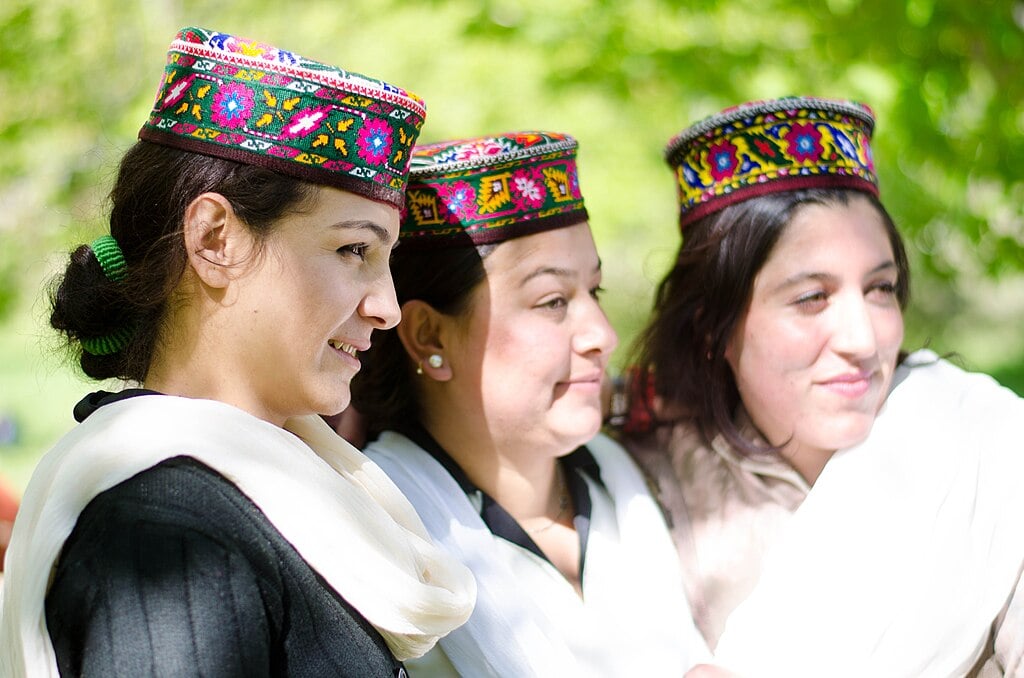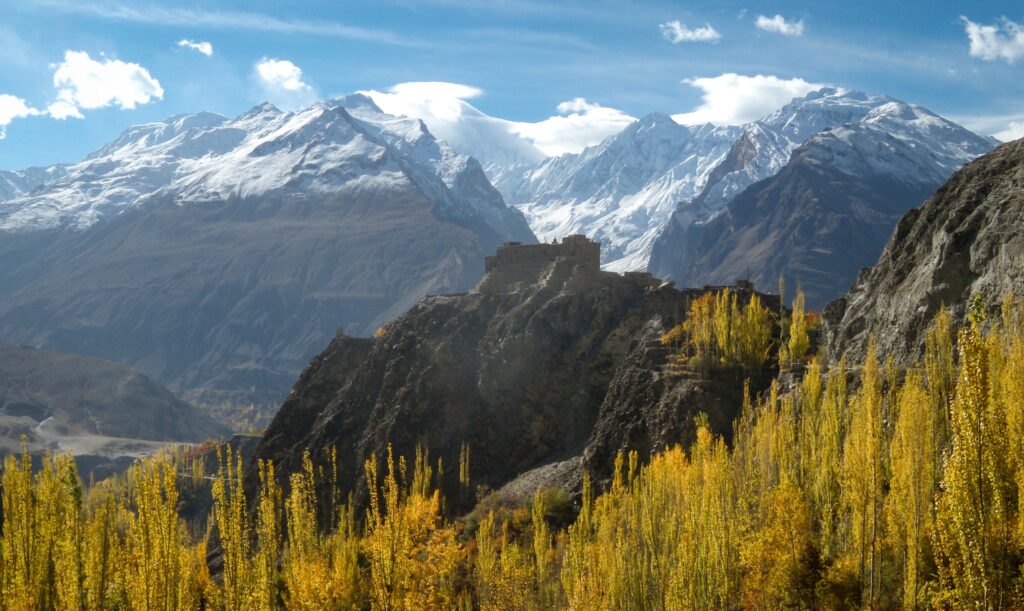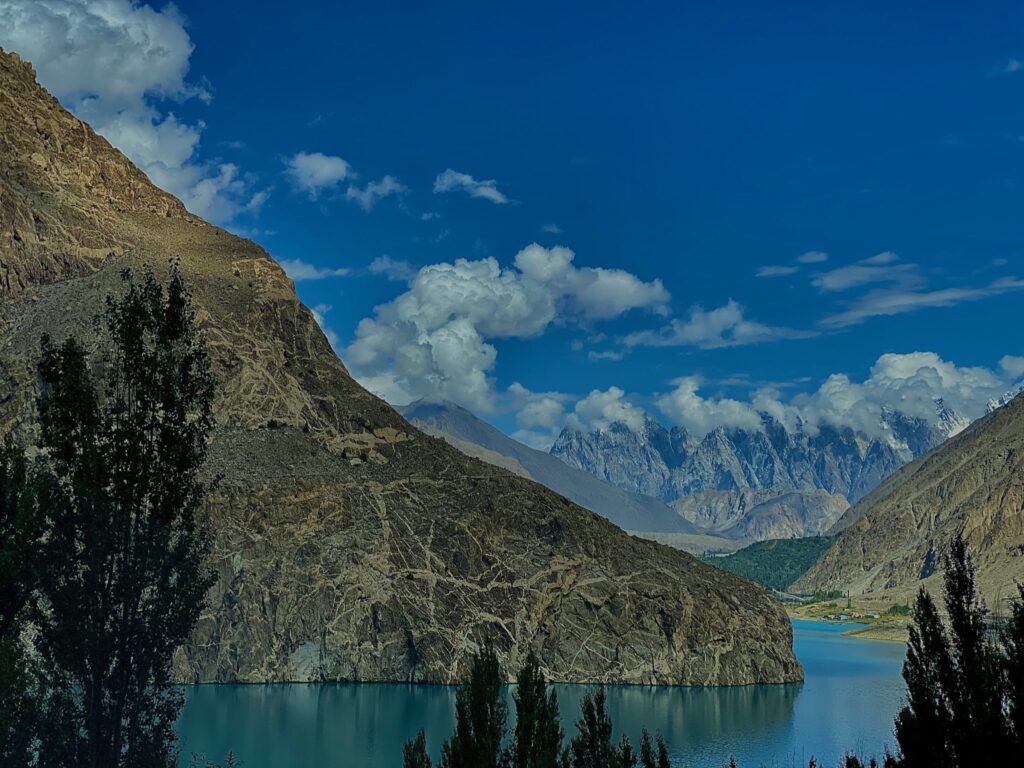Table of Contents
Geography
The Hunza Valley, situated along the Hunza River, shares its borders with Ishkoman to the northwest, Shigar to the southeast, Afghanistan’s Wakhan Corridor to the north, and China’s Xinjiang region to the northeast. The valley floor stands at an elevation of 2,438 meters (7,999 feet) above sea level. Geographically, the Hunza Valley is divided into three distinct regions: Upper Hunza (Gojal), Central Hunza, and Lower Hunza (Shinaki).
Historical and Cultural Significance of Hunza Valley

The Hunza Valley has a rich tapestry of religious and cultural history. Before the advent of Islam, Buddhism, and to a lesser extent, Bön, were the dominant religions in the region. This is evidenced by several surviving Buddhist archaeological sites, such as the Sacred Rock of Hunza. The valley played a pivotal role in the network of trading routes connecting Central Asia to the subcontinent, offering protection to Buddhist missionaries and monks. This strategic location facilitated the spread of Buddhism throughout Asia.
In the pre-Islamic era, the majority of the population in Hunza practiced Buddhism. However, with the arrival of Islam, most locals converted. Despite this religious shift, remnants of the Buddhist past remain, including ancient graffiti in the Brahmi script inscribed on rocks by Buddhist monks as acts of worship. Although many of these inscriptions were neglected or destroyed over time, efforts are now being made to restore them.
The Princely State of Hunza
Hunza was once a princely state, bordered by China’s Xinjiang region to the northeast and the Pamirs to the northwest. It remained an independent principality for over 900 years before becoming part of Pakistan. The state was dissolved in 1974 by then-Prime Minister Zulfikar Ali Bhutto. Before its dissolution, Hunza bordered the Gilgit Agency to the south and the former princely state of Nagar to the east. The state capital was the town of Baltit (now known as Karimabad), with Ganish Village being another significant settlement, historically linked to Hindu heritage, as its name “Baba Ganesh” suggests.
Hunza’s strategic importance came to the fore during the British “Great Game” in the early 1800s. In 1891, the British Empire captured Hunza, forcing its ruler, Mir Safdar Ali Khan, to flee to Kashgar, China. The British installed his brother, Mir Nazim Khan (1892-1938), as a puppet ruler, although real power was exercised by British officers stationed in Gilgit.
Mir/Tham of Hunza
According to John Biddulph’s account in his book “Tribes of the Hindoo Koosh,” the ruling family of Hunza, known as Ayesha (meaning “heavenly”), originally ruled both Hunza and Nagar. This lineage was a branch of the Shahreis, the ruling family of Gilgit. The introduction of Islam to the Gilgit region saw a Muslim ruler marry a daughter of the Trakhan of Gilgit, who bore twin sons, Moghlot and Girkis. Their rivalry led to the division of the state between them, with Girkis taking the north/west and Moghlot the south/east bank of the river, leading to the present-day separation of Hunza and Nagar.
2010 Landslide and Attabad Lake
On January 4, 2010, a massive landslide struck the region, blocking the Hunza River and creating Attabad Lake (also known as Shishket Lake). The disaster resulted in 20 deaths and eight injuries, and it blocked approximately 26 kilometers (16 miles) of the Karakoram Highway. The newly formed lake extended 30 kilometers (19 miles) and reached a depth of 400 feet (120 meters), submerging sections of the highway and significantly impacting local communities and transportation.
The history and geography of Hunza Valley, from its religious transformations and princely state era to natural disasters, paint a vivid picture of a region that has been a crucial nexus of culture, trade, and history.
Tourism

The Hunza Valley, nestled in the Gilgit-Baltistan region of Pakistan, is surrounded by an array of towering peaks, many of which exceed 7,000 meters. These majestic mountains include Rakaposhi, Distaghil Sar, Batura, Batura II, Batura III, Muchu Chhish, Kunyang Chhish, Shispare, Passu Sar, Kanjut Sar, Yukshin Gardan Sar, Pumari Chhish, and Momhil Sar.
Visitors to the valley can marvel at the views of numerous other impressive peaks such as Ultar Sar (7,388 m), Bojahagur Duanasir II (7,329 m), Ghenta Peak (7,090 m), Hunza Peak (6,270 m), Darmyani Peak (6,090 m), and the distinctive Ladyfinger Peak, also known as Bublimating (6,000 m).
A Tapestry of History and Religion
Hunza Valley boasts a diverse religious history and is home to several historic sites. The ancient watchtowers in Ganish village and the iconic Baltit Fort in Karimabad, built by the Mirs around 800 years ago, are significant landmarks. Altit Fort, located at the valley’s base, adds to the historical richness of the region.
In the 8th century AD, a large Buddha figure surrounded by smaller Bodhisattvas was discovered carved into a rock, reflecting the valley’s Buddhist heritage. Additionally, prehistoric carvings of men and animals can be found etched into rocks throughout the valley, offering a glimpse into the distant past.
Scenic Lakes and Glaciers
Hunza Valley is also home to several beautiful lakes, including Attabad Lake, Borith Lake, Shimshal Lakes, and Hassanabad Lake. Each lake adds to the serene and picturesque landscape of the valley.
The valley is home to the 57 km long Batura Glacier, the fifth-longest glacier in the world outside the polar regions. This impressive glacier is surrounded by peaks such as Shispare, Batura, and Kumpirdior, making it a remarkable natural wonder.
Strategic Passes and Hiking Trails
Khunjerab Pass, at an elevation of 4,693 meters (over 15,000 feet above sea level), holds strategic significance. It serves as a critical border crossing between Pakistan and China, connecting Gilgit-Baltistan with China’s Xinjiang region. This high-altitude pass is one of the highest paved international border crossings in the world.
For hiking enthusiasts, the valley offers treks such as Ondra Poygah Gulmit and Leopard Trek Shiskhat. These trails provide an opportunity to explore the rugged beauty of the region and encounter its diverse wildlife.
The Mythical Inspiration
Hunza Valley is often believed to be one of the inspirations for the mythical valley of Shangri-La, depicted in James Hilton’s 1933 novel, “Lost Horizon.” The valley’s stunning landscapes, serene environment, and rich cultural heritage certainly lend credence to this legend.
Hunza Valley, with its towering peaks, historical landmarks, serene lakes, and challenging treks, is a treasure trove of natural beauty and cultural heritage. Whether you are a mountaineer, a history enthusiast, or someone seeking peace and tranquility, Hunza Valley offers an unforgettable experience.
The People of Hunza Valley

In Hunza Valley, the local languages spoken are Burushaski, Wakhi, and Shina. The region boasts an impressive literacy rate of over 95%, a testament to the success of community schools and educational initiatives. The Aga Khan Mirs have played a crucial role in establishing high-quality educational institutions, including universities, which have greatly contributed to this high literacy rate, particularly among girls.
Historically, Hunza Valley and the broader northern Pakistan region have experienced significant migrations, conflicts, and resettlements of various tribes and ethnic groups. Among these, the Shina people are particularly notable in the region’s history. Over the years, the people of Hunza have preserved and passed down their rich traditions and historical narratives.
In addition to the Shina, the valley is also home to the Wakhi people, who migrated from northeastern Afghanistan in the nineteenth century. The majority of Hunza’s residents are followers of the Ismaili Shia sect of Islam, with Aga Khan IV serving as their spiritual leader and guiding figure. His influence is widely recognized for promoting literacy and enhancing the overall well-being of Hunza’s people.
The longevity of Hunza’s inhabitants has been a topic of interest. While some claim that the Hunza people live unusually long lives, this notion has been questioned due to a lack of comprehensive birth records. Critics argue that claims of extended life expectancy may be exaggerated, often based on statements from local leaders rather than empirical evidence. John Clark, an author who extensively studied the Burusho people, noted general health issues among them, which challenges the longevity claims.
Despite these debates, it is evident that the Hunza people maintain a healthy lifestyle and diet. Researchers, including Robert McCarrison, have observed that Hunza residents rarely suffer from diseases such as cancer, stomach ulcers, or appendicitis. Their lifestyle involves high levels of physical activity due to the challenging terrain, along with a diet rich in apricot seeds and oils. The glacier water, rich in minerals, also contributes to their health. Whether or not their longevity claims are fully accurate, their healthy living habits are undeniable.

Nestled in the Gilgit-Baltistan region of northern Pakistan, Hunza Valley is a paradise for nature lovers and history buffs alike. Often referred to as “Heaven on Earth,” the valley boasts a breathtaking landscape of snow-capped mountains, lush green valleys, and crystal-clear rivers.
Places to Visit
Baltit Fort
Perched on a hilltop in Karimabad, Baltit Fort is a UNESCO World Heritage Tentative Site and one of Hunza’s most iconic landmarks. Built in the 8th century, the fort offers stunning views of the surrounding valley and provides a fascinating glimpse into the region’s rich history. The architecture of the fort, with its intricate woodwork and stone masonry, reflects the cultural heritage of the Hunza Valley.
Altit Fort
Located in the town of Altit, Altit Fort is even older than Baltit Fort, dating back to the 11th century. This historic fort has been beautifully restored and offers insights into the architectural evolution of the region. The fort is not just a historical monument but also a cultural center where visitors can learn about the traditions and lifestyles of the people of Hunza.
Karimabad Bazaar
The bustling town of Karimabad, the capital of Hunza, is home to a lively bazaar. Here, you can find a wide variety of local handicrafts, souvenirs, and delicious Hunza food. The bazaar is a great place to experience the local culture, interact with friendly locals, and purchase unique items such as handmade carpets, embroidered shawls, and gemstones.
Borith Lake
Located near the village of Borith, Borith Lake is a serene high-altitude lake surrounded by meadows and snow-capped peaks. It’s an ideal spot to relax and enjoy the beautiful scenery. The tranquil environment and stunning views make it a perfect place for nature lovers and photographers.
Rush Lake
For the more adventurous, a trek to Rush Lake is a must. Situated at an elevation of over 15,000 feet, Rush Lake is one of the highest alpine lakes in the world. The trek offers breathtaking views of glaciers, valleys, and towering mountains. It is a challenging journey but incredibly rewarding for those who seek adventure and natural beauty.
Food
Hunza cuisine is known for its fresh, local ingredients and unique flavors. Some popular dishes include:
- Apricot Cake: Hunza is famous for its apricots, and apricot cake is a delicious way to enjoy them.
- Boil Boghur: A hearty stew made with lamb, vegetables, and barley.
- Chapati: A flatbread that is a staple of Pakistani cuisine.
- Ghunza Salad: A refreshing salad made with tomatoes, cucumbers, onions, and local herbs.
- Halwa: A sweet dessert made with semolina, sugar, and nuts.
These dishes reflect the simplicity and healthfulness of the local diet, often prepared with organic ingredients grown in the valley.
Activities
There are plenty of outdoor activities to enjoy in Hunza Valley, including:
- Trekking: Hunza is a trekker’s paradise, with trails to suit all levels of experience.
- Mountaineering: The towering peaks of the Karakoram Range offer a challenge for experienced mountaineers.
- Hiking: There are many beautiful hikes in the valley, offering stunning views of the scenery.
- Biking: Cycling is a great way to explore the valley at your own pace.
- Jeep Safaris: Jeep safaris are a popular way to see the sights of the valley.
- Polo: Hunza is famous for its traditional polo games, which are a great way to experience the local culture.
These activities provide visitors with ample opportunities to immerse themselves in the natural beauty and cultural richness of the valley.
Getting There
The nearest airport to Hunza Valley is Islamabad International Airport. From there, you can take a domestic flight to Gilgit Airport. Hunza Valley can then be reached by road from Gilgit. The journey by road offers spectacular views of the Karakoram Highway and the surrounding landscapes.
Where to Stay
There are a variety of hotels and guesthouses to choose from in Hunza Valley, catering to all budgets. From luxury hotels with modern amenities to cozy guesthouses that offer a more authentic experience, you will find accommodation that suits your preferences and budget.
Best Time to Visit
The best time to visit Hunza Valley is from spring to autumn (April to October). The weather is pleasant during these months, and the skies are clear, making it ideal for outdoor activities and sightseeing. Winter can be very cold in Hunza Valley, with temperatures well below freezing, but it also offers a unique beauty with snow-covered landscapes.
Things to Know Before You Go
- Remote Location: Hunza Valley is a remote location, so it’s important to be prepared for limited amenities.
- Warm Clothes: Be sure to pack plenty of warm clothes, even in summer, as the nights can be cold.
- Cash: There are ATMs in Karimabad, but it’s a good idea to bring some cash with you as well.
- Dress Modestly: Hunza Valley is a conservative Islamic region, so it’s important to dress modestly. Women should cover their shoulders and legs.
With its stunning landscapes, rich history, and vibrant culture, Hunza Valley is a destination that promises an unforgettable experience. Whether you’re an adventurer, a history enthusiast, or simply seeking a peaceful retreat, Hunza has something to offer everyone.
Conclusion
Hunza Valley, with its stunning landscapes, rich history, and vibrant culture, is a remarkable destination that offers a blend of natural beauty and cultural heritage. From its towering peaks and serene lakes to its historic forts and diverse ethnic communities, Hunza Valley provides a unique experience for travelers and history enthusiasts alike. The valley’s high literacy rate, driven by dedicated educational efforts and the influence of the Aga Khan Mirs, reflects a commitment to progress and development. While the claims of extraordinary longevity among its inhabitants remain debated, the healthy lifestyle and diet of the Hunza people are well-documented. Whether you’re drawn by its breathtaking scenery, historical significance, or the intriguing cultural narratives, Hunza Valley promises an unforgettable journey into one of Pakistan’s most captivating regions.

FAQs
1. What languages are spoken in Hunza Valley?
Hunza Valley’s primary languages are Burushaski, Wakhi, and Shina.
2. Why is the literacy rate in Hunza Valley so high?
The high literacy rate is attributed to the establishment of community schools, high-quality education initiatives, and the influence of the Aga Khan Mirs, who have played a significant role in promoting education in the region.
3. What are some of the notable peaks in Hunza Valley?
Hunza Valley is surrounded by several impressive peaks, including Rakaposhi, Distaghil Sar, Batura, Shispare, and Passu Sar, among others.
4. Are there any historical sites to visit in Hunza Valley?
Yes, Hunza Valley is home to several historical sites, including Baltit Fort, Altit Fort, and ancient watchtowers in Ganish village. These sites offer insights into the region’s rich history and cultural heritage.
5. What lakes can be found in Hunza Valley?
The valley features several beautiful lakes, such as Attabad Lake, Borith Lake, Shimshal Lakes, and Hassanabad Lake.
6. Is there a significant glacier in Hunza Valley?
Yes, Hunza Valley is home to the Batura Glacier, which is the fifth-longest glacier in the world outside the polar regions.
7. What is the significance of Khunjerab Pass?
Khunjerab Pass is a strategically important high-altitude pass on the northern border of Pakistan and the southwestern border of China. It is one of the highest paved international border crossings in the world.
8. What are some popular hiking trails in Hunza Valley?
Popular hiking trails in Hunza Valley include Ondra Poygah Gulmit and Leopard Trek Shiskhat, which offer opportunities to explore the valley’s rugged terrain and stunning landscapes.
9. Is Hunza Valley connected to any famous myths or legends?
Hunza Valley is believed to have inspired the mythical valley of Shangri-La, described in James Hilton’s 1933 novel “Lost Horizon.”
10. What is the general health and longevity of the Hunza people?
While claims of exceptional longevity among the Hunza people are debated, their healthy lifestyle, including a diet rich in apricot seeds and glacier water, and high levels of physical activity, are well-documented.




